Polskie samogłoski nosowe graficznie zapisywane jako <ę> i <ą>. Różnorodność badań w zakresie fonetyki audytywnej, artykulacyjnej i akustycznej
Polish Nasal Vowels Written Graphically as <ę> and <ą>. A Variety of Studies on Auditive, Articulatory and Acoustic Phonetics
Author(s): Sofia KamińskaSubject(s): Language and Literature Studies
Published by: Oficyna Wydawnicza ATUT – Wrocławskie Wydawnictwo Oświatowe
Keywords: nasal vowels, nasality; experimental techniques; auditory research; acoustic research; articulatory research
Summary/Abstract: This text attempts to collect and present the more important Polish and worldwide research on vowel nasality. The article showcases the diversity of research conducted over the decades to carry out a description of nasal vowels, including Polish nasal vowels graphically written as <ę> and <ą>. Nasal vowels are complex sounds in terms of articulation. Studies have been carried out by linguists (phoneticians, phonologists) as well as researchers from other disciplines, including medicine, physiology, and physics. The interdisciplinary nature of the research carried out meant utilizing various research techniques and methods. In chronological order, these included palatography, kymography, labiography, electromyography, fibero-optic endoscopy, radiography, MRI, ultrasonography, velotrace device, X-ray microbeam, electromagnetic articulation, and nazometry. Auditory studies have also been a significant part of the research, especially in adults and children. Research on nasal vowels aimed to better understand functioning of muscles controlling the activity of the soft palate and pharyngeal wall, analysing velar-pharyngeal movements, and aerodynamic conditions created by the varied movements of active articulators. These studies also explored the impact of the acoustic signal on listeners. The review concludes that contemporary instrumental techniques are very sought-after and often used in research on nasality. However, such studies involve a small group of participants. It therefore seems that auditory research could complement and enrich the results of research conducted with experimental techniques.
Journal: Linguistische Treffen in Wrocław
- Issue Year: 26/2024
- Issue No: 2
- Page Range: 369-387
- Page Count: 19
- Language: Polish

